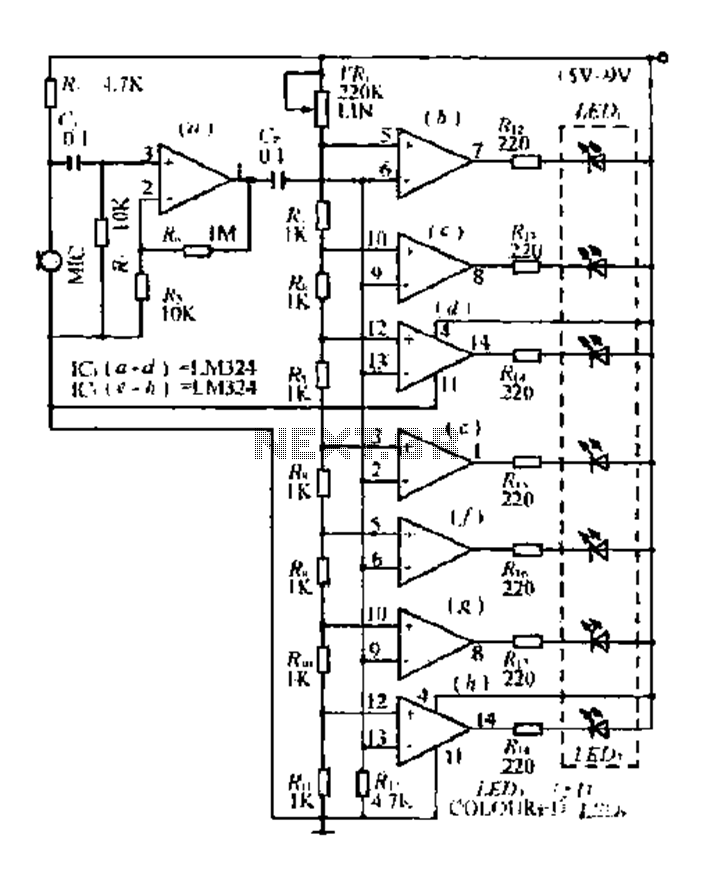
Liquid level Alert

This circuit will emit an intermittent beep (or will flash a LED) when the water contained into a recipient has reached the desired level. It should be mounted on top of the recipient (e.g. a plastic tank) by means of two crocodile clips, acting also as probes. If a deeper sensing level is needed, the clips can be extended by means of two pieces of stiff wire. More: IC1, a 555 CMOS timer chip, is wired as an astable multivibrator whose operating frequency is set by C1, R1 and R2, plus the resistance presented by water across the probes. If the resistance across the probes is zero (i.e. probes shorted), the output frequency...
This circuit utilizes a 555 CMOS timer integrated circuit (IC1) configured in astable mode to create a square wave output that can be used to drive a piezo buzzer or an LED indicator. The astable multivibrator configuration allows the circuit to produce a continuous signal that varies in frequency based on the resistance detected between the two probes (crocodile clips) submerged in water.
The frequency of oscillation is determined by the resistors R1 and R2, along with the timing capacitor C1. As the water level rises and makes contact between the probes, the resistance across them decreases, thus modifying the frequency of the output signal. This change in frequency can be observed as a variation in the beep rate of the buzzer or the flashing rate of the LED.
For practical implementation, the crocodile clips should be securely attached to the top of the tank, ensuring that they are positioned at the desired water level. If a deeper sensing capability is required, the clips can be extended using stiff wires, maintaining electrical contact with the water.
Additional components may include a diode for reverse polarity protection and a resistor for current limiting, particularly if an LED is used as the output indicator. Proper selection of C1, R1, and R2 values will be crucial to achieving the desired sensitivity and response time of the circuit.
In summary, this water level detection circuit offers a simple yet effective solution for monitoring liquid levels in various applications, utilizing basic electronic components to provide visual or audible alerts when the threshold is met.This circuit will emit an intermittent beep (or will flash a LED) when the water contained into a recipient has reached the desired level. It should be mounted on top of the recipient (e.g. a plastic tank) by means of two crocodile clips, acting also as probes. If a deeper sensing level is needed, the clips can be extended by means of two pieces of stiff wire. IC1, a 555 CMos timer chip, is wired as an astable multivibrator whose operating frequency is set by C1, R1 and R2, plus the resistance presented by water across the probes. If the resistance across the probes is zero (i.e. probes shorted), the output fre 🔗 External reference
This circuit utilizes a 555 CMOS timer integrated circuit (IC1) configured in astable mode to create a square wave output that can be used to drive a piezo buzzer or an LED indicator. The astable multivibrator configuration allows the circuit to produce a continuous signal that varies in frequency based on the resistance detected between the two probes (crocodile clips) submerged in water.
The frequency of oscillation is determined by the resistors R1 and R2, along with the timing capacitor C1. As the water level rises and makes contact between the probes, the resistance across them decreases, thus modifying the frequency of the output signal. This change in frequency can be observed as a variation in the beep rate of the buzzer or the flashing rate of the LED.
For practical implementation, the crocodile clips should be securely attached to the top of the tank, ensuring that they are positioned at the desired water level. If a deeper sensing capability is required, the clips can be extended using stiff wires, maintaining electrical contact with the water.
Additional components may include a diode for reverse polarity protection and a resistor for current limiting, particularly if an LED is used as the output indicator. Proper selection of C1, R1, and R2 values will be crucial to achieving the desired sensitivity and response time of the circuit.
In summary, this water level detection circuit offers a simple yet effective solution for monitoring liquid levels in various applications, utilizing basic electronic components to provide visual or audible alerts when the threshold is met.This circuit will emit an intermittent beep (or will flash a LED) when the water contained into a recipient has reached the desired level. It should be mounted on top of the recipient (e.g. a plastic tank) by means of two crocodile clips, acting also as probes. If a deeper sensing level is needed, the clips can be extended by means of two pieces of stiff wire. IC1, a 555 CMos timer chip, is wired as an astable multivibrator whose operating frequency is set by C1, R1 and R2, plus the resistance presented by water across the probes. If the resistance across the probes is zero (i.e. probes shorted), the output fre 🔗 External reference





